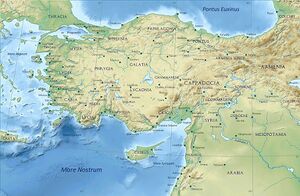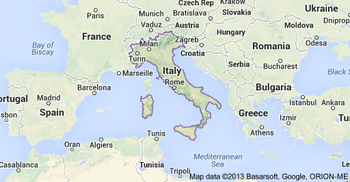Bithynia
| Author:Laxman Burdak, IFS (R) |

Bithynia (/bɪˈθɪniə/; Koine Greek: Βιθυνία, Bithynía) was an ancient region, kingdom and Roman province in the northwest of Asia Minor, adjoining the Propontis, the Thracian Bosporus and the Euxine Sea. Arrian, the historian of Alexander the Great, was born in Nicomedia (present-day İzmit), the provincial capital of Bithynia.
Variants of name
- Bithynia (Anabasis by Arrian, p. 77, 108.)
- Bithyni (tribe)
- Bithynian
- Bithynians
Jat Gotras Namesake
- Bathiyan = Bithynia (Anabasis by Arrian, p. 77, 108.)
Location

It bordered Mysia to the southwest, Paphlagonia to the northeast along the Pontic coast, and Phrygia to the southeast towards the interior of Asia Minor.
History
Bithynia was an independent kingdom from the 4th century BC. Its capital Nicomedia was rebuilt on the site of ancient Astacus in 264 BC by Nicomedes I of Bithynia. Bithynia was bequeathed to the Roman Republic in 74 BC, and became united with the Pontus region as the province of Bithynia et Pontus. In the 7th century it was incorporated into the Byzantine Opsikion theme. It became a border region to the Seljuk Empire in the 13th century, and was eventually conquered by the Ottoman Turks between 1325 and 1333.
According to Strabo, Bithynia was bounded on the east by the river Sangarius (modern Sakarya river), but the more commonly received division extended it to the Parthenius, which river separated it from Paphlagonia, thus comprising the district inhabited by the Mariandyni. On the west and southwest it was separated from Mysia by the river Rhyndacus and on the south it adjoined Phrygia and Galatia.[1]
Iron Age: Bithynia is named for the Thracian tribe of the Bithyni, mentioned by Herodotus (VII.75) alongside the Thyni. The "Thraco-Phrygian" migration from the Balkans to Asia Minor would have taken place at some point following the Bronze Age collapse or during the early Iron Age. The Thyni and Bithyni appear to have settled simultaneously in the adjoining parts of Asia, where they expelled or subdued the Mysians, Caucones and other minor tribes, the Mariandyni maintaining themselves in the northeast. Herodotus mentions the Thyni and Bithyni as settling side by side.[2] No trace of their original language has been preserved, but Herodotus describes them as related to the tribes of Thracian extraction like the Phrygians and Armenians, whose languages form part of the Paleo-Balkan group.
Later the Greeks established on the coast the colonies of Cius (modern Gemlik); Chalcedon (modern Kadıköy), at the entrance of the Bosporus, nearly opposite Byzantium (modern Istanbul) and Heraclea Pontica (modern Karadeniz Ereğli), on the Euxine, about 120 miles east of the Bosporus.[3]
The Bithynians were incorporated by king Croesus within the Lydian monarchy, with which they fell under the dominion of Persia (546 BC), and were included in the satrapy of Phrygia, which comprised all the countries up to the Hellespont and Bosporus.[4]
Kingdom of Bithynia: Even before the conquest by Alexander the Bithynians appear to have asserted their independence, and successfully maintained it under two native princes, Bas and Zipoites, the latter of whom assumed the title of king (basileus) in 297 BC.
His son and successor, Nicomedes I, founded Nicomedia, which soon rose to great prosperity, and during his long reign (c. 278 – c. 255 BC), as well as those of his successors, Prusias I, Prusias II and Nicomedes II (149 – 91 BC), the kingdom of Bithynia had a considerable standing and influence among the minor monarchies of Anatolia. But the last king, Nicomedes IV, was unable to maintain himself in power against Mithridates VI of Pontus. After being restored to his throne by the Roman Senate, he bequeathed his kingdom through his will to the Roman republic (74 BC).[2]
The coinage of these kings show their regal portraits, which tend to be engraved in an extremely accomplished Hellenistic style.[5]
Roman province: As a Roman province, the boundaries of Bithynia changed frequently. During this period, Bithynia was commonly united for administrative purposes with the province of Pontus. This was the situation at the time of Emperor Trajan, when Pliny the Younger was appointed governor of the combined provinces (109/110 – 111/112), a circumstance which has provided historians with valuable information concerning the Roman provincial administration at that time.
Byzantine province: Under the Byzantine Empire, Bithynia was again divided into two provinces, separated by the Sangarius. Only the area to the west of the river retained the name of Bithynia.[6]
Bithynia attracted much attention because of its roads and its strategic position between the frontiers of the Danube in the north and the Euphrates in the south-east. To secure communications with the eastern provinces, the monumental bridge across the river Sangarius was constructed around 562 AD. Troops frequently wintered at Nicomedia.
During this time, the most important cities in Bithynia were Nicomedia, founded by Nicomedes, and Nicaea. The two had a long rivalry with each other over which city held the rank of capital.
Jat History
Tun (तूण) Jat clan: H. W. Bellew[7] writes that Tun or Tani, probably represent the Thrakian Thynoi, who moved into these parts in the time of Alexander, from their Asiatic settlement in Bithynia. Tun is gotra of Jats found in Afghanistan.[8]
Strabo was born in a wealthy family from Amaseia in Pontus (modern Amasya Turkey),[9] which had recently become part of the Roman Empire. Pontus fell to the Roman general Pompey in 63 BC and after the murder or suicide of Mithridates VI of Pontus was broken up into smaller provinces in 64 BC. Strabo in Book 12 Chapter 3 Section 41 states that the Romans took possession of Bithynia "a little before my time", setting the date of his birth to after 63 BC.
External links
References
- ↑ Chisholm, Hugh, ed. (1911). "Bithynia". Encyclopædia Britannica. 4 (11th ed.). Cambridge University Press. pp. 12–13.
- ↑ Chisholm, Hugh, ed. (1911). "Bithynia". Encyclopædia Britannica. 4 (11th ed.). Cambridge University Press. pp. 12–13.
- ↑ Chisholm, Hugh, ed. (1911). "Bithynia". Encyclopædia Britannica. 4 (11th ed.). Cambridge University Press. pp. 12–13.
- ↑ Chisholm, Hugh, ed. (1911). "Bithynia". Encyclopædia Britannica. 4 (11th ed.). Cambridge University Press. pp. 12–13.
- ↑ Asia Minor Coins - regal Bithynian coins
- ↑ Chisholm 1911, p. 13.
- ↑ An Inquiry Into the Ethnography of Afghanistan By H. W. Bellew, 1891, p.16
- ↑ An Inquiry Into the Ethnography of Afghanistan By H. W. Bellew, 1891, p.14,28
- ↑ Geography Book XII Chapter 3 Section 15, "Amaseia, my fatherland."

